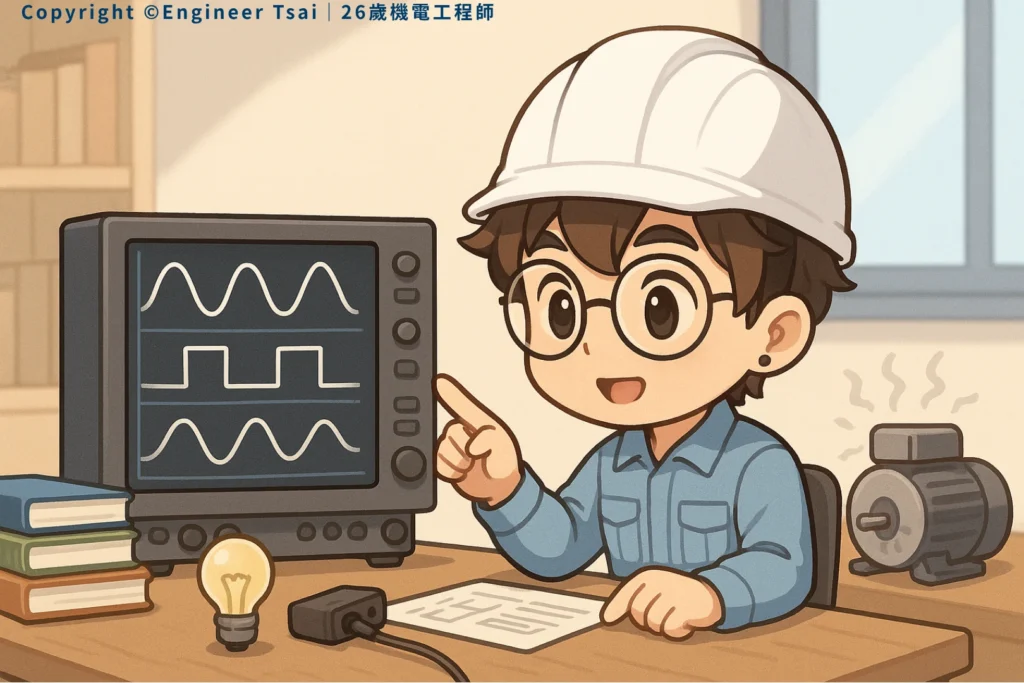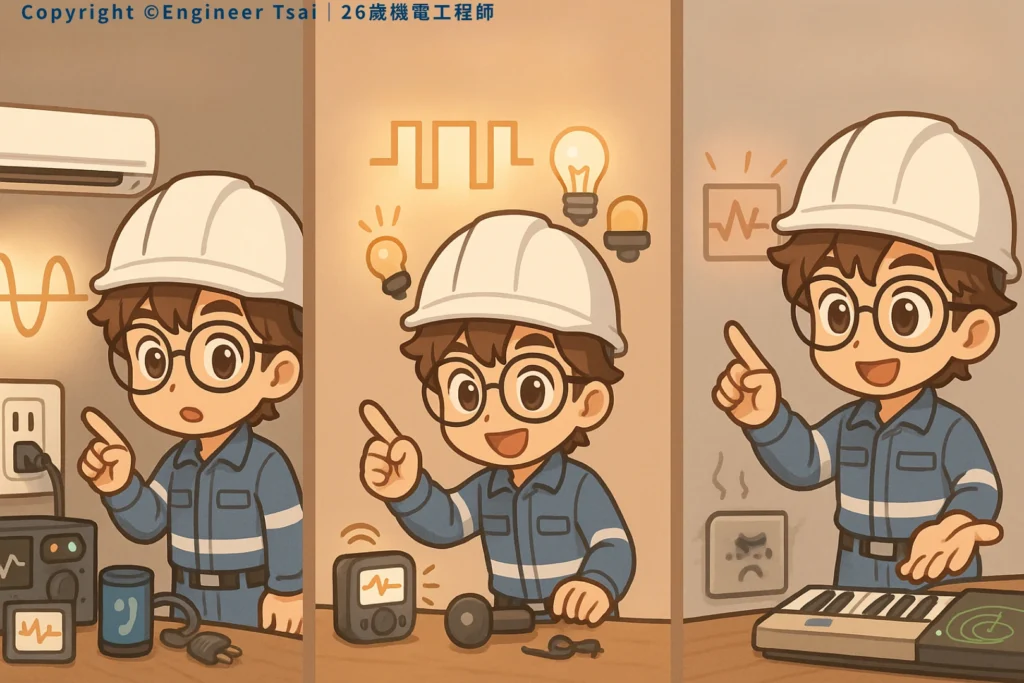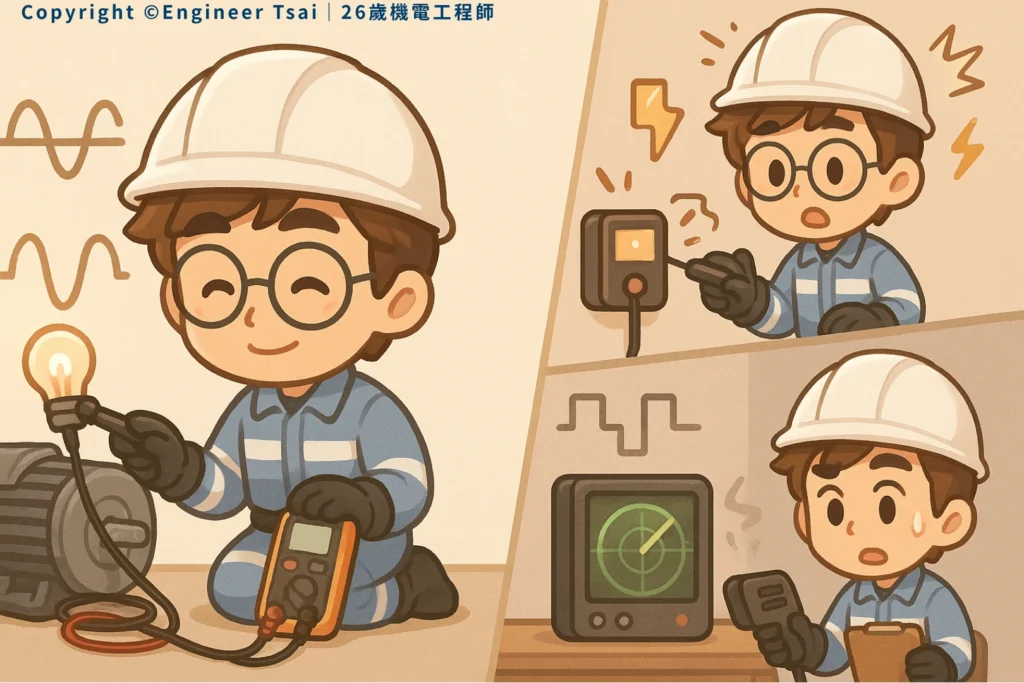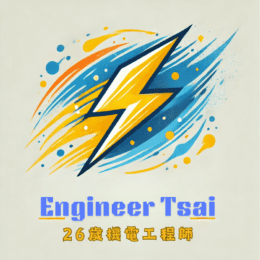▶️ 立即觀看:交流變直流有多難?整流器一次看懂!
你知道嗎?手機、筆電、各種電子設備,其實都吃「直流電」。
但插座送來的卻是交流電——這中間, 整流器 扮演了關鍵角色!
Ever seen those wavy lines on a heart monitor? Or the sound waves jumping around in your video editing app?
Yep, those lines are called waveforms—and they’re everywhere.
But waveforms aren’t just for engineers. They’re behind how your AC powers on, how your earbuds play your favorite song, and even how your washing machine spins at just the right speed.
They’re basically how your electronics talk and listen.
In this article, we’re breaking down the three most common types of waveforms—sine, square, and sawtooth—in the simplest way possible.
We’ll look at what they look like, how they work, and why they matter in your everyday life.

Chapter 1: What’s a Waveform—and Why Should You Care?
At its core, a waveform is just the shape of how voltage or current changes over time.
Think of it like:
- The emotional curve of electricity
- A controller’s set of instructions to a motor
- The shape of every sound you hear in music
Waveforms help us “see” what the electricity is doing at any moment.
If the line stays flat, the voltage is steady. If it rises and falls, something’s changing.
And those changes matter.
They affect how devices behave, how audio sounds, and whether your electronics stay safe—or risk overheating.
Chapter 2: The Sine Wave — Smooth, Steady, and Safe
The sine wave is like the “mother of all waveforms.”
It’s the clean, flowing curve that powers most of the world’s electrical grids.
What it looks like:
A smooth, curvy S-shape that rises and falls like gentle ocean waves.
What makes it special:
It transitions smoothly, without any sudden jumps. That makes it easier on machines and minimizes heat and electrical noise.
Where it’s used:
In your home’s AC power, air conditioner motors, medical equipment, and audio systems.
Why it matters:
The sine wave delivers power in the most efficient and stable way possible.
Think of it like a calm river—quietly and reliably moving energy to wherever it’s needed.

Chapter 3: The Square Wave — Fast, Sharp, and No-Nonsense
The square wave is the no-chill, all-action type.
What it looks like:
Straight up, straight down—no easing in or out. It’s like flipping a light switch: ON or OFF, no in-between.
Key trait:
It’s either full voltage or zero. Nothing in the middle.
Where it shows up:
Digital signals (like binary 0s and 1s), basic motor controls, buzzers, and blinking LEDs.
What makes it useful:
It’s quick, simple, and cheap. But there’s a catch:
That sudden on-off switching creates electrical noise and can interfere with other circuits. Over time, it can even wear out sensitive devices.
Picture a boss who yells “Go!” the second you walk in. Super efficient—but kind of stressful, right?
Chapter 4: The Sawtooth Wave — The Climb-and-Drop Rhythm
The sawtooth wave looks just like its name—sharp, jagged, and relentless.
What it looks like:
Voltage ramps up gradually, then suddenly drops. Up, down, repeat.
Key trait:
It’s directional and rhythmic, but not smooth. Think of it like running wind sprints—go, reset, go again.
Where it shows up:
Synthesizers (those gritty sound effects), old-school TVs, radar displays, and scanners.
Why it’s used:
That predictable rise and drop is great for mimicking real-world motion—like climbing voltage steps or vibrating systems.
But because it’s not gentle like a sine wave, you’ll mostly find it in specialized gear that needs this kind of waveform.
Imagine a timer that climbs toward a goal—then BAM, back to zero. Over and over again.

Chapter 5: Different Waveforms, Different Outcomes
Think of waveforms like different tones of voice.
- Sine wave? It’s like a calm explanation.
- Square wave? A strict command.
- Sawtooth wave? A constant push-and-reset reminder.
In electrical systems, these “tones” directly shape what happens next:
- Will a motor spin smoothly or jerk around?
- Will the power supply stay stable or fluctuate?
- Will the device stay cool or overheat?
- Will the sound be soothing or harsh?
Choosing the wrong waveform isn’t just a small mistake.
It can mess up an entire circuit.
Final Thoughts: Waveforms Are How Electricity Speaks
Most people learning about electricity only ask:
“How many volts?” or “How much current?”
But here’s the truth:
Voltage is just the number. The waveform is the message.
It’s not just how much power you deliver—
It’s how that power changes over time that really matters.
So next time you see a signal on a scope,
don’t just look at how high or low it goes.
Ask yourself:
👉 “What is this rhythm trying to make the device do?”
📌 Further Reading Suggestions
🔹 Fundamentals of Voltages: How to Drive Current?
Voltage is what sets the waveform in motion—learn how they work together.
🔹 Practical Guide to Inductance in AC Circuits: Design, Reactance, and Efficiency
Find out what happens when waveforms meet magnetic resistance.
🔹 How Do Electric Motor Work? DC, AC, and Brushless Motors Simplified
Motors respond differently depending on the waveform—here’s how to match them right.
💬 Your Turn
Ever seen a waveform that really stuck with you?
Or had a device freak out because of a bad signal?
Drop a comment—let’s decode the rhythm of electricity together.
#EngineerTsai #Waveform101 #ElectronicsForEveryone


